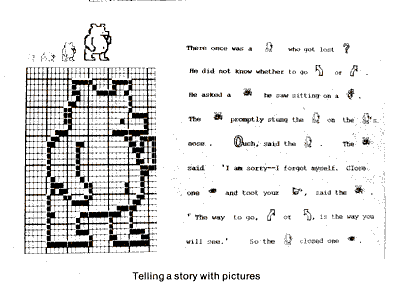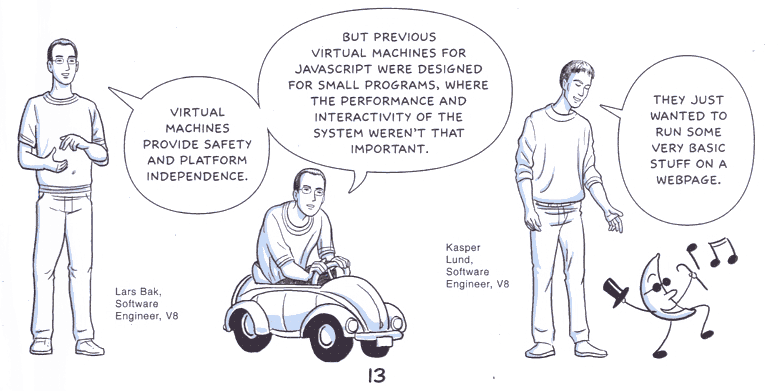My first day taking Ada to school. I survived 6AM, and Ada was very good at briefing me on what daddies do at school. She taught me a “Spanish” song phonetically, although I think she may, Borges-like, be teaching me her own imaginary language.
I comb her hair a bit too much in the morning, because I don’t want the other kids to think she’s an odd kid. I was an odd kid. My hair was all over the place (still is, though less of it), and I was always distracted by lucky experiences I’d struggle to explain. At eight, I remember getting teased at my village school by classmates and my teacher because I claimed that my dad had a computer in his room. My teacher pointed out that if that was true, there wouldn’t be much room for my dad in that room: computers were huge, of course. When I said that he let me program it, they really started teasing.
Back then, I had these elaborate, vivid and private fantasies of what the future of the world would be like. When I was 11, a lot of them were based on this article about the Dynabook, re-published in 1980:
Imagine having you own self-contained knowledge manipulator in a portable package the size and shape of an ordinary notebook. Suppose it had enough power to outrace your senses of sight and hearing, enough capacity to store for later retrieval thousands of page-equivalents of reference material, poems, letters, recipes, records, drawings, animations, musical scores, waveforms, dynamic simulations, and anything else you would like to remember and change.
Such flights of imagination are what one would expect to find as the basis for a well-written science fiction novel, or perhaps as the musings of a Creative Conmputerist wishing she could carry the school computer system to the park and use the text-editing facilities to write poetry while sitting under a tree. It isn’t often that such an idea is the basis for a serious research effort by a major company, in this case the Learning Research Group of the Xerox Palo Alto Research Center (PARC) which recently released its latest report on Personal Dynamic Media — the Dynabook.
 I remember every image in this article. I painstakingly transferred that image of a bear onto graph paper, and tried to recreate a SmallTalk “dynamic page” in BBC Basic. It was so close I could taste it. Sometimes I got angry that I was just a kid, and everything was taking so damn long to arrive.
I remember every image in this article. I painstakingly transferred that image of a bear onto graph paper, and tried to recreate a SmallTalk “dynamic page” in BBC Basic. It was so close I could taste it. Sometimes I got angry that I was just a kid, and everything was taking so damn long to arrive.
I was reminded about all of this, because I was doing research about Google Chrome for the Irish Times column, and daydreaming again while reading Scott McCloud’s beautiful imagery, and thinking: this is what I thought Dynabook pages would look like, only instead of static comics telling a story so well, they would be alive, and dance and be pull-apartable, like a kit car.

And, of course, the recursive truth here is that this booklet includes a description of the element of the modern Dynabook, the Web on a laptop, that could bring those images of really dynamic media alive: Javascript.
To Alan Kay (and the hypertext pioneers), the design of the modern Web page inside out. When you’re writing a page for the Web, as I am now, I’m building it from stringing text together, just as would write a normal book. I’m barely leavening it with any programming functionality at all. In the Dynabook, the aim was to bring the dynamism of the computer to the masses: tools to be able to create pictures as easily as words, and animation as easily as both: but all of them really just subsets of — not programming, but whatever it is that computers provide us as an opportunity. “Interaction” sucks as a term, but I think we may be stuck with it.
The Dynabook — and Alan Kay’s dream still remains — an educational project. What was it trying to teach? I think what it was trying to teach was what I was lucky to get at eight because of my dad’s fictional computer, and which I genuinely believe everyone can, and should have.
Unfortunately, the best term for it has already been debased, and is anyway one of those anachronistic portmanteaus like “horseless carriage” (or Dynabook, for that matter). It’s computer literacy: but let me tell you what that means to me.
As regular readers will already have noted, by professional standards, I’m not great shakes as a programmer. It’s just something I do because I enjoy it, and it’s useful in my everyday life. Yet people regularly marvel that I can do it at all, and wish that they could. I think they can, but the reason they can’t is because they weren’t taught it when they were five, as Ada is being taught reading, and writing, and mathematics, and Spanish.
I think that’s criminal, in the 21st century. Watching my child learn reading and writing, it’s perfectly obvious to me that this is an incredibly hard and unnatural feat, that we’ve somehow managed to consistently teach to >99% of the population of the developed world. We’ve managed that because we have had hundreds of years of trial-and-error training on how to do it.
I think that if some of us applied the same dedication to teaching programming, we’d have the same percentage of coding literacy: a future generation who could wield every part of the computing experience as well as they could a pen. Most of them might be, by the professional standards of today’s programmers, barely coders at all: but that’s like elegant scribes of the past sneering at the slate-scrawling graduates of the first public schools. (Actually, I don’t think that would be the case: I think a huge minority of modern coders are people who don’t really feel any affinity to or ability for the job, but have been obliged to learn it because of extenuating circumstances. Someone trained from kindergarten would knock their abilities into a cocked hat.)
Reading, writing, ‘rithmetic, and ‘raction. Learning your ABCs, your 123s, and your iterations, abstractions, and recursions.
Alan Kay was – and still is – trying to build that platform, and that educational experience, with the Dynabook. We’ve now got the infrastructure in the Web, Javascript, and modern technology. Like in 1980, trained by accident to see the obvious, it’s so close I can taste it. I don’t know how we got to Gutenberg to universal literacy, but that’s the path we need to walk down now. I want true literacy for my daughter.

September 4th, 2008 at 4:13 am
This is a blazingly obvious point, but in the absence of it being in the school curriculum, I’m assuming that you’re going to try some at home?
It never even occurred to me, but it’s a very good point. Are there any “learn to code” books for kids? The question itself sounds ridiculous.
If there aren’t any, maybe there should be. There’s a call to arms.
Er, not necessarily to you, or anything.
October 9th, 2008 at 6:50 pm
> I think that’s criminal, in the 21st century.
I fully agree!